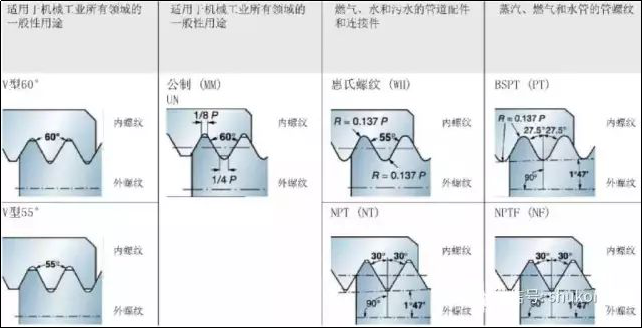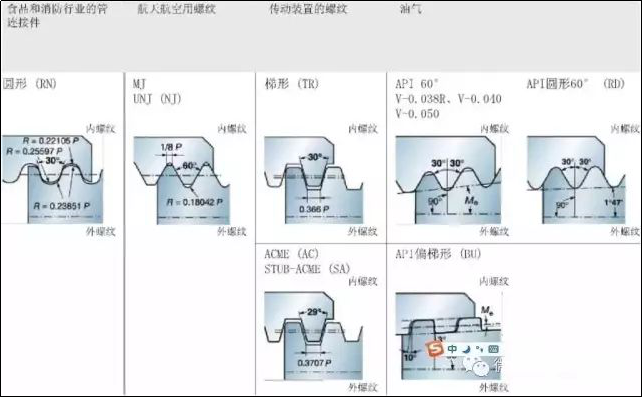Everyone is familiar with the thread. As colleagues in the manufacturing industry, we often need to add threads according to customer needs when processing hardware accessories such as CNC machining parts, CNC turning parts and CNC milling parts.
1. What is thread?
A thread is a helix cut into a workpiece either from the outside or from the inside. The main functions of threads are:
1. Form a mechanical connection by combining internal thread products and external thread products.
2. Transfer motion by converting rotary motion to linear motion and vice versa.
3. Obtain mechanical advantages.
2. Thread profile and terminology
The thread profile determines the geometry of the thread, including the workpiece diameter (major, pitch, and minor diameters); thread profile angle; pitch and helix angle.
1. Thread terms
① Bottom: The bottom surface connecting two adjacent thread flanks.
② flank: the thread side surface that connects the crest and the bottom of the tooth.
③Crest: The top surface connecting the two flanks.
P = pitch, mm or threads per inch (t.p.i.)
ß = profile angle
ϕ = thread helix angle
d = major diameter of external thread
D = major diameter of internal thread
d1 = minor diameter of external thread
D1 = Minor diameter of internal thread
d2 = pitch diameter of external thread
D2 = internal thread pitch diameter
Pitch diameter, d2/D2
Effective diameter of the thread. About halfway between the major and minor diameters.
The geometry of the thread is based on the thread pitch diameter (d, D) and the pitch (P): the axial distance along the thread on the workpiece from one point on the profile to the corresponding next point. This can also be seen as a triangle bypassing the workpiece.
vc = cutting speed (m/min)
ap = total thread depth (mm)
nap = total thread depth (mm)
t.p.i. = threads per inch
Feed = pitch
2. Ordinary thread profile
1. Calculation and tolerance of external thread pitch diameter of 60° tooth type (national standard GB197/196)
a. Calculation of the basic size of pitch diameter
The basic size of the pitch diameter of the thread = the major diameter of the thread – pitch × coefficient value.
Formula representation: d/D-P×0.6495
2. Calculation and tolerance of pitch diameter of 60°internal thread (GB197/196)
a.6H level thread pitch diameter tolerance (based on thread pitch)
Upper limit:
P0.8+0.125P1.00+0.150P1.25+0.16P1.5+0.180
P1.25+0.00P2.0+0.212P2.5+0.224
The lower limit value is “0″,
The upper limit calculation formula 2+TD2 is the basic size + tolerance.
For example, the pitch diameter of M8-6H internal thread is: 7.188+0.160=7.348 Upper limit: 7.188 is the lower limit.
b. The calculation formula of the pitch diameter of the internal thread is the same as that of the external thread
That is, D2=D-P×0.6495, that is, the middle diameter of the internal thread is equal to the major diameter of the thread-pitch×coefficient value.
c.6G class thread pitch diameter basic deviation E1 (based on thread pitch)
P0.8+0.024P1.00+0.026P1.25+0.028P1.5+0.032
P1.75+0.034P1.00+0.026P2.5+0.042
3. Calculation and tolerance of major diameter of external thread (GB197/196)
a. The upper limit of the 6h major diameter of the external thread
That is, the thread diameter value example M8 is φ8.00 and the upper limit tolerance is “0″.
b. Tolerance of the lower limit value of the major diameter of the 6h class of the external thread (based on the thread pitch)
P0.8-0.15P1.00-0.18P1.25-0.212P1.5-0.236P1.75-0.265
P2.0-0.28P2.5-0.335
Calculation formula for the lower limit of the major diameter: d-Td is the basic dimension of the major diameter of the thread – tolerance.
4. Calculation and tolerance of small diameter of internal thread
a. Calculation of the basic size of the small diameter of the internal thread (D1)
The basic size of the small diameter of the thread = the basic size of the internal thread – pitch × factor
5. Calculation formula of dividing head single dividing method
Calculation formula of single division method: n=40/Z
n: the number of revolutions that the dividing head should turn
Z: Equal fraction of workpiece
40: fixed number of dividing head
6. Calculation formula of hexagon inscribed in a circle
① Find the hexagonal opposite side (S surface) of circle D
S=0.866D is diameter×0.866 (coefficient)
② Calculate the diameter of the circle (D) from opposite sides of the hexagon (S surface)
D=1.1547S is opposite side×1.1547 (coefficient)
7. Calculation formula of hexagonal opposite sides and diagonals in cold heading process
① Find the opposite angle e from the opposite side (S) of the outer hexagon
e=1.13s is opposite side×1.13
②Find the opposite angle (e) from the opposite side (s) of the inner hexagon
e=1.14s is opposite side×1.14 (coefficient)
③ Find the material diameter of the head of the opposite corner (D) from the opposite side (s) of the outer hexagon
The diameter of the circle (D) should be calculated according to (the second formula in 6) the hexagonal opposite side (s surface), and the offset center value should be increased appropriately, that is, D≥1.1547s. The amount of offset center can only be estimated.
8. Calculation formula of square inscribed in a circle
① Circle (D) to find the opposite side of the square (S surface)
S=0.7071D is diameter×0.7071
② Find the circle (D) from opposite sides of the square (S surface)
D=1.414S is opposite side×1.414
9. Calculation formula of square opposite sides and opposite angles in cold heading process
① Find the opposite angle (e) from the opposite side (S) of the outer square
e=1.4s is the opposite side (s)×1.4 parameter
② Find the opposite angle (e) from the opposite side (s) of the inner square
e=1.45s is the opposite side (s)×1.45 coefficient
10. The formula for calculating the volume of a hexagon
s20.866×H/m/k means opposite side×opposite side×0.866×height or thickness.
11. Calculation formula of volume of frustum (cone) body
0.262H(D2+d2+D×d) is 0.262×height×(big head diameter×big head diameter+small head diameter×small head diameter+big head diameter×small head diameter).
12. Calculation formula for the volume of a spherical body (such as a semicircular head)
3.1416h2(R-h/3) is 3.1416×height×height×(radius-height÷3).
13. Calculation formula for machining dimensions of taps for internal threads
1. Calculation of tap major diameter D0
D0=D+(0.866025P/8)×(0.5~1.3) is the basic size of tap large diameter thread + 0.866025 pitch ÷ 8×0.5 to 1.3.
Note: The choice of 0.5 to 1.3 should be confirmed according to the size of the pitch. The larger the pitch value, the smaller coefficient should be used. On the contrary, the smaller the pitch value, the corresponding larger coefficient should be used.
2. Calculation of tap pitch diameter (D2)
D2=(3×0.866025P)/8, that is, tap diameter=3×0.866025×pitch÷8
3. Calculation of tap diameter (D1)
D1=(5×0.866025P)/8 is the tap diameter=5×0.866025×pitch÷8
14. Calculation formula for the length of materials used for cold heading forming in various shapes
It is known that the volume formula of a circle is diameter×diameter×0.7854×length or radius×radius×3.1416×length. That is, d2×0.7854×L or R2×3.1416×L
When calculating, the volume X÷diameter÷diameter÷0.7854 or X÷radius÷radius÷3.1416 of the material required for processing cnc machining parts and cnc turning parts is the length of the material.
Column formula = X/(3.1416R2) or X/0.7854d2
X in the formula represents the volume value of the required material;
L represents the length value of the actual feeding;
R/d represents the radius or diameter of the actual feeding.
Post time: Jan-11-2023



